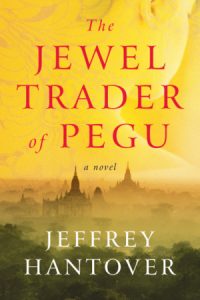The Story Behind the Book
THE JEWEL TRADER OF PEGU by Jeffrey Hantover

People assumed, because my wife was an expert in Chinese art, that I also knew something about Asian art. I kept quiet, smiled politely, and soon found myself the art and antiques columnist for the Hong Kong Tattler, a magazine read more for its society party pictures than its prose. In 1991 the American owner of a local gallery asked me to accompany him to Vietnam to interview artists and write the catalogue essay for a major exhibition of contemporary Vietnamese art. In that invitation lay the seed for The Jewel Trader of Pegu.
Trying to learn as much as I could about Vietnamese history and culture – of which I knew almost nothing – I cast my research net broadly. I came across Southeast Asia in the Age of Commerce 1450-1680 by the Australian historian, Anthony Reid, a work full of contemporary European travelers’ observations on life in kingdoms and cities that are now only exotic names and backwaters. In the section on marriage customs I was intrigued by this simple sentence – “In Pegu and other ports of Burma and Siam, foreign traders were asked to initiate brides.” Though he then had no name or nationality, the central character of the book was born. What would a European trader do if faced with the demand to perform this rite alien to his own beliefs and culture?
On one of my trips to Ho Chi Minh City, bouncing along in a pedicab I saw a crowd of young men by the side of the road. One man stood separate from the others, most of whom crouched on their haunches as men do in Asia. He had short, dark curly hair, unlike the straight hair of most Vietnamese, and his skin was darker than the others: he looked to me like an Amerasian – the son of an African-American soldier and a Vietnamese woman. I knew then my European trader would fall in love and have a son.
Other assignments kept the trader confined between the lines of note cards and my journal. At some point in those years, he went from being an Elizabethan Englishman to a Venetian Jew named Abraham. Pegu with its broad avenues, its gold leafed pagodas and palaces, its polyglot exoticism stood in contrast to the Venetian ghetto’s narrow alleys and damp gray stones. Freed from the physical confines of the ghetto and the expectations of others – Jews and gentiles – and confronted with a culture and faith so different from his own, would this young man change? I could map out the physical journey he had taken, but I didn’t know where the inner journey would end.
For a decade I turned away from prose to write poetry, and though the note cards yellowed, the memory work of my poetry made me better able to give voice to Abraham – to let him tell his story more directly. When I finally returned to the world of Pegu, I felt an urgency to tell the story. I had created characters but had left them living in limbo. I was haunted by the words of the Jesuit travelers that are the epilogue of the book and was afraid that if I didn’t write their story, Abraham and Mya would be buried in the silence that had fallen upon Pegu.
But I still struggled with how to make Abraham’s voice heard. Robert Bonfil in Jewish Life in Renaissance Italy gave me the key to unlock his voice. Letter writing, Bonfil wrote, was one of the most frequent forms of literary expression among Renaissance Jews: letter writing was a pillar of a child’s primary education, and children wrote daily letters to their fathers, even if they lived in the same house. It was the custom to write letters to relatives and friends about the day’s events, about ideas – about everything. Late at night, the wind rustling the palm trees outside his wooden house, Abraham, first alone and later with the woman he loved sleeping nearby, could now break his silence.
Now I could find out what Abraham would do. Now I could find out what choices he would make.

